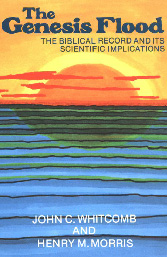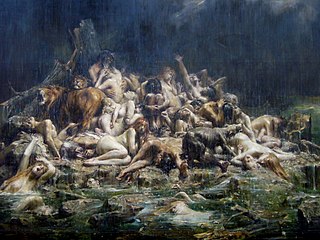
Creation science or scientific creationism is a pseudoscientific form of Young Earth creationism which claims to offer scientific arguments for certain literalist and inerrantist interpretations of the Bible. It is often presented without overt faith-based language, but instead relies on reinterpreting scientific results to argue that various myths in the Book of Genesis and other select biblical passages are scientifically valid. The most commonly advanced ideas of creation science include special creation based on the Genesis creation narrative and flood geology based on the Genesis flood narrative. Creationists also claim they can disprove or reexplain a variety of scientific facts, theories and paradigms of geology, cosmology, biological evolution, archaeology, history, and linguistics using creation science. Creation science was foundational to intelligent design.

Kenneth Alfred Ham is an Australian Christian fundamentalist, young Earth creationist, apologist and former science teacher, living in the United States. He is the founder, CEO, and former president of Answers in Genesis (AiG), a Christian apologetics organisation that operates the Creation Museum and the Ark Encounter.

Young Earth creationism (YEC) is a form of creationism which holds as a central tenet that the Earth and its lifeforms were created by supernatural acts of the Abrahamic God between about 6,000 and 10,000 years ago. In its most widespread version, YEC is based on the religious belief in the inerrancy of certain literal interpretations of the Book of Genesis. Its primary adherents are Christians and Jews who believe that God created the Earth in six literal days. This is in contrast with old Earth creationism (OEC), which holds literal interpretations of Genesis that are compatible with the scientifically determined ages of the Earth and universe. It is also in contrast to theistic evolution, which posits that the scientific principles of evolution, the Big Bang, abiogenesis, solar nebular theory, age of the universe, and age of Earth are compatible with a metaphorical interpretation of the Genesis creation account.

Old Earth creationism (OEC) is an umbrella of theological views encompassing certain varieties of creationism which may or can include day-age creationism, gap creationism, progressive creationism, and sometimes theistic evolutionism.

Day-age creationism, a type of old Earth creationism, is an interpretation of the creation accounts in Genesis. It holds that the six days referred to in the Genesis account of creation are not literal 24-hour days, but are much longer periods. The Genesis account is then reconciled with the age of the Earth. Proponents of the day-age theory can be found among both theistic evolutionists, who accept the scientific consensus on evolution, and progressive creationists, who reject it. The theories are said to be built on the understanding that the Hebrew word yom is also used to refer to a time period, with a beginning and an end and not necessarily that of a 24-hour day.

Flood geology is a pseudoscientific attempt to interpret and reconcile geological features of the Earth in accordance with a literal belief in the Genesis flood narrative, the flood myth in the Hebrew Bible. In the early 19th century, diluvial geologists hypothesized that specific surface features provided evidence of a worldwide flood which had followed earlier geological eras; after further investigation they agreed that these features resulted from local floods or from glaciers. In the 20th century, young-Earth creationists revived flood geology as an overarching concept in their opposition to evolution, assuming a recent six-day Creation and cataclysmic geological changes during the biblical flood, and incorporating creationist explanations of the sequences of rock strata.

The history of creationism relates to the history of thought based on the premise that the natural universe had a beginning, and came into being supernaturally. The term creationism in its broad sense covers a wide range of views and interpretations, and was not in common use before the late 19th century. Throughout recorded history, many people have viewed the universe as a created entity. Many ancient historical accounts from around the world refer to or imply a creation of the earth and universe. Although specific historical understandings of creationism have used varying degrees of empirical, spiritual and/or philosophical investigations, they are all based on the view that the universe was created. The Genesis creation narrative has provided a basic framework for Jewish and Christian epistemological understandings of how the universe came into being – through the divine intervention of the god, Yahweh. Historically, literal interpretations of this narrative were more dominant than allegorical ones.

The Institute for Creation Research (ICR) is a creationist apologetics institute in Dallas, Texas, that specializes in media promotion of pseudoscientific creation science and interpretation of the Genesis creation narrative as a historical event. The ICR adopts the Bible as an inerrant and literal documentary of scientific and historical fact as well as religious and moral truths, and espouses a Young Earth creationist worldview. It rejects evolutionary biology, which it views as a corrupting moral and social influence and threat to religious belief. The ICR was formed by Henry M. Morris in 1972 following an organizational split with the Creation Science Research Center (CSRC).

The Creation Research Society (CRS) is a Christian fundamentalist group that requires of its members belief that the Bible is historically and scientifically true in the original autographs, belief that "original created kinds" of all living things were created during the Creation week described in Genesis, and belief in flood geology.

The Genesis Flood: The Biblical Record and its Scientific Implications is a 1961 book by young Earth creationists John C. Whitcomb and Henry M. Morris that, according to Ronald Numbers, elevated young Earth creationism "to a position of fundamentalist orthodoxy."

Henry Madison Morris was an American young Earth creationist, Christian apologist and engineer. He was one of the founders of the Creation Research Society and the Institute for Creation Research. He is considered by many to be "the father of modern creation science". He coauthored The Genesis Flood with John C. Whitcomb in 1961.

In creationism, a religious view based on a literal reading of the Book of Genesis and other biblical texts, created kinds are purported to be the original forms of life as they were created by God. They are also referred to in creationist literature as kinds, original kinds, Genesis kinds, and baramins.
Walter T. Brown is a young Earth creationist, who is the director of his own ministry called the Center for Scientific Creation. The Skeptic's Dictionary considers him to be one of the leaders of the creation science movement. He proposes a specific version of flood geology called the Hydroplate Theory. He is a retired army officer with a degree in mechanical engineering.

Grand Canyon: A Different View is a 2003 book edited by Tom Vail. The book features a series of photographs of the Grand Canyon illustrating 20 essays by creationists Steve Austin, John Baumgardner, Duane Gish, Ken Ham, Russell Humphreys, Henry Morris, John D. Morris, Andrew A. Snelling, Larry Vardiman, John Whitcomb, and Kurt Wise. It presents the Young Earth creationist perspective that the canyon is no more than a few thousand years old and was formed by the Global Flood or Noachian flood of the Bible.
Leonard Brand is a Seventh-day Adventist creationist, biologist, paleontologist, and author. He is a professor and past chair of Loma Linda University Department of Earth and Biological Sciences.
Andrew A. Snelling is a young-Earth creationist geologist who works for Answers in Genesis.
The Biblical Creation Society (BCS) is a United Kingdom-based creationist organisation founded in 1977 by Scottish minister Nigel M. de S. Cameron (now President of the Center for Policy on Emerging Technologies and a group of evangelical students, who were concerned about the popularity of theistic evolution among conservative Christians, but were repelled by the "wholly negative" attitude of the Evolution Protest Movement. Although inspired by the scientific creationism of John C. Whitcomb and Henry M. Morris, it refused to limit its membership to only Young Earth creationists, and in its name rejected American attempts to separate scientific creationism from its Biblical roots. The organisation is based in Rugby, Warwickshire.

The Genesis flood narrative is a Hebrew flood myth. It tells of God's decision to return the universe to its pre-creation state of watery chaos and remake it through the microcosm of Noah's ark.
Kevin R. Henke is an American geochemist and former instructor at the University of Kentucky's department of Geology. He currently works as a senior research scientist at the University of Kentucky's Center for Applied Energy Research. He is well known for his criticism of young earth creationism and the scientific arguments they make for a young earth. In particular, he has been critical of the RATE project's results, which claim to show that zircons contain too much helium to be billions of years old, and has argued that Russell Humphreys, a young-earth creationist who was involved in the project, has made errors in his research. These flaws include that, according to Henke, "The vast majority of Humphreys et al.'s critical a, b, and Q/Q0 values that are used in these "dating" equations are either missing, poorly defined, improperly measured or inaccurate." Henke has also accused Humphreys of misidentifying his specimens, fudging his data, and not considering the possibility of helium contamination in this research. He has also criticized John Woodmorappe for arguing that radiometric dating is unreliable. On one occasion, Henke called Kent Hovind on the phone regarding Hovind's $250,000 challenge to "prove" evolution. Hovind told Henke that in order to win the money he would have to recreate the Big Bang in a laboratory. Henke responded by proposing several alternative "proofs" that pertained to geology, but Hovind refused, saying that the project must be chosen by him and it must not pertain to the area in which Henke has scientific expertise. Hovind therefore required Henke to prove that dogs and bananas had a common ancestor, and lowered the award to only $2,000 should he succeed. Henke accepted the challenge, and later drafted a contract, which was then posted on Talk.origins. However, one of Henke's requirements was that the judges be unbiased, and Hovind rejected the challenge for this reason, insisting that he should be the only one who can choose the judges.

Is Genesis History? is a 2017 American Christian film by Thomas Purifoy Jr. that promotes the pseudoscientific notion of Young Earth creationism, a form of creation science built on beliefs that contradict established scientific facts regarding the origin of the Universe, the age of the Earth and universe, the origin of the Solar System, and the origin and evolution of life. The film suggests the Earth was created in six days of 24-hours each in opposition to day-age creationism, and also advocates the Genesis biblical narratives of Adam and Eve, the fall, the global flood, and the tower of Babel. It grossed $2.6 million in theatres and $3.3 million in video sales.









